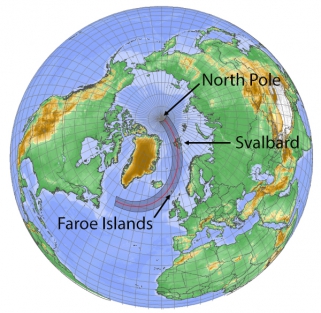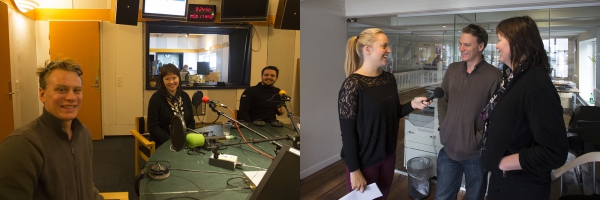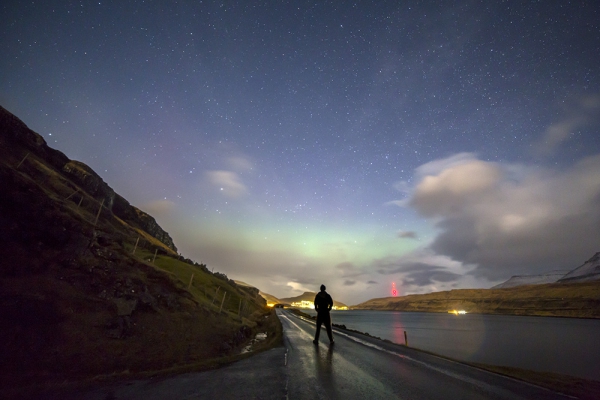by Dr. Geoff Sims
- Published: Saturday, April 26 2014 06:15
A total solar eclipse is arguably the most amazing natural sight one can ever witness. During this precise alignment of the Earth, Moon and Sun, anyone lucky enough to be situated in the path of the Moon's shadow will observe daylight turn to an eerie twilight darkness for a brief few minutes. During totality, the Sun's outer atmosphere, the corona, becomes visible as a brilliant greyish-gold colour, shimmering behind the Moon, a now stark black silhouette. The chromosphere - the Sun's inner atmospheric layer - glows pink from Hydrogen-alpha emission around the lunar limb. Animals will behave like it's dawn/dusk, while human "eclipse chasers" will revel in the euphoric experience of it all.
I am one such eclipse chaser, having now seen seven total solar eclipses since I first got the bug in 2002. The next total solar eclipse will occur on the 20th March, 2015, and will be visible from a narrow path traversing the North Atlantic, crossing only two landmasses: The Faroe Islands and Svalbard.

Path of the 2015 Total Solar Eclipse. Credit: Jay Anderson
During March this year (2014), I was privileged to be invited to join fellow eclipse chaser Dr. Kate Russo on an education and outreach "pre-eclipse" trip to the Faroe Islands, generously supported by their tourism organisation, Visit Faroe Islands. The Faroe Islands are a self-governing country under the Kingdom of Denmark, situated at a latitude of 62 N and roughly due north of Great Britain. This small and little-known archipelago of 18 main islands is home to around 50,000 people, and 100,000 sheep - it is no wonder that the word "Faroe" is derived from the ancient Faroese words for "sheep" and "islands"!
The ease of access (direct flights from both Copenhagen and London) and excellent infrastructure position the Faroe Islands as the prime location for next year's eclipse, with thousands of eclipse chasers expected to converge there. As a bonus, these islands also host some of the most dramatic, rugged landscapes you could ever dream of.
 Dramatic scenery at the village of Viðareiði
Dramatic scenery at the village of Viðareiði
Aside from general promotion of the eclipse, our goals while visiting the islands were specifically to prepare the authorities on what to expect (logistical arrangements, traffic control, additional accommodation, etc.) and to educate the community (including government officials, tour guides, school children, and the general public) about the eclipse, attempting to explain why thousands of crazy people like us travel around the world to watch the Moon dance in front of the Sun. News of our arrival spread fast, and within hours of landing, we already had numerous radio and newspaper interviews scheduled - our PR was off to a good start!

Radio interviews in the TÛrshavn, the capital city
The days which followed were very productive, and included presentations to large groups as well as visits to primary schools. It was such a pleasure teaching the local kids about the eclipse, and we were extremely impressed at the enthusiasm they showed: each student came preprepared with a unique question to ask us. Many of the kids had also heard stories from their grandparents about the previous total solar eclipse that occurred in the Faroes in 1954, adding to their anticipation of next year's event. We taught them about eye safety during solar eclipses, and they were more than happy to pose for a photo with their new shades, courtesy of Sydney Observatory.

School children learning about safe solar viewing with their eclipse glasses
The weather in the Faroe Islands is known to be exceedingly cloudy and ever-changing unpredictably. In view of this, another exciting venture we were involved in was a "citizen science" eclipse weather monitoring project. We enlisted a number of volunteers scattered around the islands (mainly from the regional tourism offices), to monitor the sky conditions around the Sun every day at eclipse time (9:40 am) during the month of March 2014.
Their observations - over 350 in total - will be used to produce some statistics on visibility of the eclipse and the usefulness of weather forecasts for practical eclipse viewing, which we hope to publish in a peer-reviewed journal. In addition to simple statistics, the project has the added benefit of creating a heightened awareness about weather and the eclipse in general for the many people directly and indirectly involved. If more people are curious about astronomy as a result of their participation, then the project can be deemed a success!
 Location of observers, and snapshot of submitted photographs to the eclipse weather project
Location of observers, and snapshot of submitted photographs to the eclipse weather project
During some free evenings, I took the opportunity to drive around the islands to do some night photography, in search of the elusive Aurora Borealis. There is an excellent road network for exploring the archipelago, with bridges and tunnels connecting most islands. Conditions for photography were challenging to say the least, with sub-zero (degrees C) temperatures, unpredictable weather and often gale-force winds.

Shooting the sky at KlaksvÌk, ninja-style.
It paid to be patient, however, as the clouds often parted providing a pristine window to the northern skies, and on occasion, the northern lights.
 The Aurora Borealis from Suðuroy
The Aurora Borealis from Suðuroy
In summary, we had a most enjoyable and rewarding week educating the public about the upcoming total solar eclipse. The Faroe Islands should be on your "places to visit" list, regardless of the eclipse: the geography is simply amazing and the local people are warm, friendly and hospitable. The Faroese communities are very excited and enthusiastic about the impending solar eclipse, and look forward to welcoming visitors from all over the world who make the journey there next year.

Alone in the Faroe Islands. What are you waiting for?
###
 Dr. Geoff Sims is an astronomer based in Sydney, Australia. He obtained his PhD in 2013, specialising in astronomy from Antarctica. During that time he helped to establish a new terahertz observatory at the coldest and driest place on Earth: Ridge A. Outside of academia, Geoff is an extremely passionate astro photographer, regularly travelling the globe to observe and photograph solar eclipses. Geoff has been involved in outreach and communication for over 10 years, and currently also works casually as an astronomy guide at the historic Sydney Observatory. You can follow his photography expeditions on Facebook, Twitter (@beyond_beneath), Instagram, Vimeo and the Web.
Dr. Geoff Sims is an astronomer based in Sydney, Australia. He obtained his PhD in 2013, specialising in astronomy from Antarctica. During that time he helped to establish a new terahertz observatory at the coldest and driest place on Earth: Ridge A. Outside of academia, Geoff is an extremely passionate astro photographer, regularly travelling the globe to observe and photograph solar eclipses. Geoff has been involved in outreach and communication for over 10 years, and currently also works casually as an astronomy guide at the historic Sydney Observatory. You can follow his photography expeditions on Facebook, Twitter (@beyond_beneath), Instagram, Vimeo and the Web.








Comments